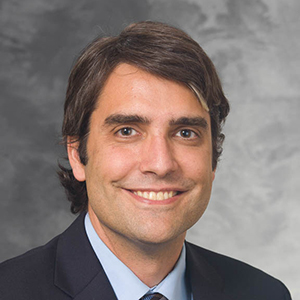 Assistant Professor Diego Hernando, PhD started the Quantitative Imaging Methods Lab (QIML) when he was recruited as faculty in 2016. QIML aims to transform MRI into a quantitative imaging modality and to develop quantitative imaging biomarkers to improve the detection, staging, and treatment monitoring of various diseases. This work is highly interdisciplinary, and the lab frequently collaborates with personnel from the Departments of Radiology, Medical Physics, Mechanical Engineering, Medicine, Urology, the School of Veterinary Medicine, and more, as well as with industry partners. Continue reading to learn more about QIML and their exciting research projects.
Assistant Professor Diego Hernando, PhD started the Quantitative Imaging Methods Lab (QIML) when he was recruited as faculty in 2016. QIML aims to transform MRI into a quantitative imaging modality and to develop quantitative imaging biomarkers to improve the detection, staging, and treatment monitoring of various diseases. This work is highly interdisciplinary, and the lab frequently collaborates with personnel from the Departments of Radiology, Medical Physics, Mechanical Engineering, Medicine, Urology, the School of Veterinary Medicine, and more, as well as with industry partners. Continue reading to learn more about QIML and their exciting research projects.
Dr. Hernando has a long-standing interest in medical imaging, particularly MRI, and its evolution from qualitative to quantitative imaging methods. “Quantitative imaging has enormous potential to enable improved clinical research, such as clinical trials for drug development, and improved clinical care, such as precision medicine. However, there are a number of technical and translational challenges that need to be addressed before this potential can be realized,” says Dr. Hernando.
The collaborative nature of QIML and his engineering background put Dr. Hernando in a strong position to address these challenges. Dr. Hernando studied Telecommunication Engineering in undergrad, before getting a master’s in Computer Engineering and a PhD in Electrical Engineering. This technical background, combined with the wealth of knowledge of their collaborators, helps Dr. Hernando and QIML meet the complex challenges faced when tackling quantitative imaging.
Despite the challenges, the work in QIML is engaging and highly rewarding. A typical research project starts out as theoretical, and moves through prototype implementation, optimization, and validation in phantoms before moving on to volunteers and patients. As the research moves along this pipeline, more collaborators from various fields join the project. “One of the most exciting moments for our research happens when a given method, which we have conceived theoretically as a small team, starts to gain steam and appreciation from others. This is a great source of motivation and encouragement for us, particularly for the trainees within our group, who have a chance to make an impact with their research projects,” says Dr. Hernando.
In particular, Dr. Hernando mentions two projects he has worked on recently with lab members that have moved through this pipeline. One project, led by graduate student Annie Zhang, studied novel methods for reliable diffusion MRI of the abdomen. Another project, led by graduate student Ruiyang Zhao, focused on methods for “snap-shot” rapid quantification of fat and iron in the liver. It’s exciting for the lab to see their work move quickly to validation and application in patients, in order to ultimately improve patient care.
QIML is currently working on a lot of exciting research projects. One of these projects is focused on developing new methods for abdominal and pelvic MRI, including chemical shift encoded methods for fat and iron quantification, and diffusion MRI for the assessment of cancer. Excess iron accumulation can occur in patients with genetic hemochromatosis and with transfusion-dependent anemias. If left untreated, the excess iron can result in severe complications. Developing novel techniques for iron quantification in tissues can help monitor and maintain safe iron levels in vulnerable patient populations. Similarly, advanced imaging techniques to quantify fat deposition throughout the body are important given the obesity epidemic and high prevalence of metabolic syndrome.
The lab is also developing new imaging test objects, called phantoms, for quantitative MRI. Quantitative MRI methods are being used more frequently for non-invasive diagnosis, staging, and treatment monitoring, both in clinical care and clinical trials. However, there is a need for MRI phantoms that accurately mimic various tissue properties in order to develop and evaluate emerging MRI biomarkers. Phantoms can also be used for quality assurance, calibration, and qualification of MRI scanners used in multicenter drug development trials. These new phantoms will help the QIML as well as other MRI research groups as they continue to innovate quantitative MRI methods.
In addition to these projects, Dr. Hernando is very interested in machine learning. Many of the lab’s projects have a machine learning component. This interest led Dr. Hernando to co-found the UW Machine Learning for Medical Imaging initiative, which aims to foster interdisciplinary collaboration between machine learning experts and medical imaging researchers at UW to address current problems in medical imaging.
Looking towards the future, the lab will continue to conduct research and develop MRI that is quantitative, automated, reproducible, and has high clinical value. And the lab’s future is looking bright. “Dr. Hernando brings an advanced signals and systems-based approach to address important clinical and biological problems with advanced MRI methods. He is an international leader in quantitative imaging biomarkers and his work is already changing how we practice clinical MRI, particularly for diseases of the abdomen and pelvis,” says Professor Scott Reeder, MD, PhD.
The lab is excited to continue growing and taking on new research projects. Dr. Hernando teaches two Medical Physics courses that cover the fundamentals of medical imaging. He hopes to continue pushing the lab on the forefront of quantitative imaging methods. “We are always looking for new collaborators and research challenges so we can keep contributing to this growing and important field in medical imaging,” says Dr. Hernando.
Learn more about the lab and its current research at: https://qiml.radiology.wisc.edu/
